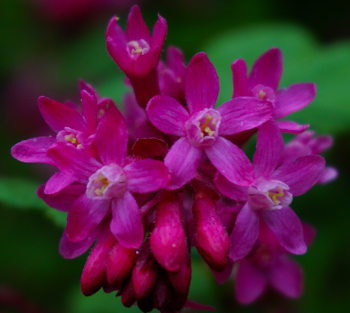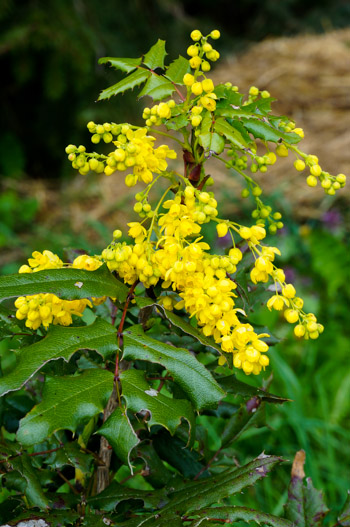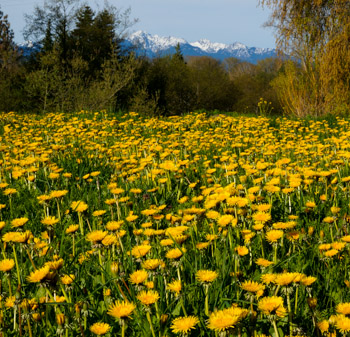Do you keep a record of what is bloom throughout the year? Since we started providing homes for bees, I have become much more aware of what is blooming when – particularly during those months on either end of the warm season, when the weather is unsettled and food for them can be scarce.
It seems many of the first to bloom are some of our natives. Perhaps it is Nature’s way of taking care of her own. If anyone needs a reason to plant native plants: the Red Flowering Currant should suffice!
If there is a color that represents the month of April, I would have to choose Brilliant Yellow!
Oh, Mahonia – I think I would name a daughter after you if I were given the chance again – the harbinger of spring – nourishing the bees as we emerge from winter; feeding feathered friends through the fall – roots and bark providing strength to those who understand their powers – Mahonia, I love you! Another great reason to plant natives!
Speaking of yellows – every year, this forsythia seems to get more brilliant! Maybe it is the contrast with the drab gravel roadside where it somehow survives – but oh my! What a greeting!
And if we’re talking about yellow – we HAVE to mention Dandelions: the King of yellow flowers! It is my sincere belief that one can NEVER have too many Dandelions! WHY, oh WHY would anyone think to spray with a “weed killer” these beautiful flowers that give us such abundant joy?? Take one bite of the glorious blossoms – add the nutritious greens to a salad – make a fermented flower wine – or just shine them under the chin of your favorite munchkin…. one can only shake one’s head in bewilderment at the folly of not appreciating such a gift of Spring!
However, if there were but one flower to represent the call of spring, I suppose it would be the daffodil trumpet. If you have a chance to make it to Mount Vernon for the Tulip Festival, I highly recommend going just a bit early to see the fields of daffodils. That said, I have to say – I have never seen a bee on a daffodil. My feeling is that they are so manipulated by the flower industry for qualities of beauty and symmetry rather than for pollen and nectar, that they are no longer a viable food source for our pollinator friends. (I have a definite bias if we are talking about bulbs that don’t require pollination: at least we can eat garlic!) Even so, daffodils bring joy – and I have read that they help to deter grass – which are two good reasons to plant them anyway!
~*~
Here is a list of what was blooming on our back acre in late March / early April (just before the cherry blooms – we are a good week later than folks in town).
[su_row]
[su_column size=”1/3″]Earliest Blooms:
Cornelian Cherry
Crocus
Currants – red & black
Currant, Red Flowering (Native)
Daffodil
Dandelion
Forget-me-not
Forsythia
Goumi Shrub
Hazels / Filberts
Heather
Honeyberries
Hyacinth
Korean Bush Cherry
Lamium “Pink Pewter”[/su_column]
[su_column size=”1/3″]
Lingonberries
Lungwort
Magnolia
Mahonia / Oregon Grape
Mustard Family/Brassicas
Nanking Cherry
Pansies
Periwinkle
Phlox
Primroses
Pulmonaria
Purple Deadnettle
Rock Cress
Rosemary
Willows[/su_column]
[su_column size=”1/3″]Additional Early- to Mid-April
Apples
Blueberries
Brassicas
Cherries
Elder
Gooseberries, assorted
Hazelnut: Contorted
Highbush cranberry / American Cranberry
Huckleberry, Native
Japanese Andromeda, Pieris
Jostaberry
Miner’s Lettuce
Money Plant / Lunaria / Honesty
Plum / Italian Prune
Quince – Flowering
Saskatoon
Strawberries
Sweet Cicely
Tulip
Viburnum, Manchurian
Woodruff, Sweet [/su_column]
[/su_row]
More photos in the Garden Walk pages – and I keep adding pics as time permits!











What a lovely article, and a fantastic selection of plants to choose from. I’m also very passionate about pollinators and am very excited about all of my new plants blooming for the first time this spring. 😀
Thank you so much for your kind comment! I love this time of year when each new bud is like a revelation! I have noticed the bees going out on nice days and they are bring back pollen! Yay! We have some hazels that have had their catkins open for some time; some pussy willows down the road are in full bloom (I should get some!); and I just noticed the mahonia and the purple deadnettle is starting to open up. Spring is not far away!